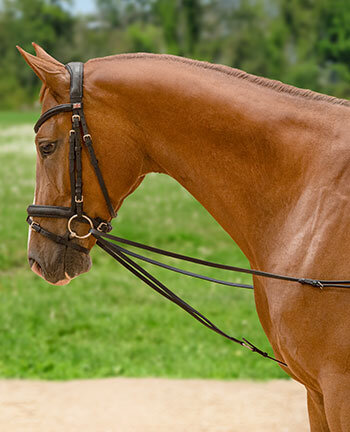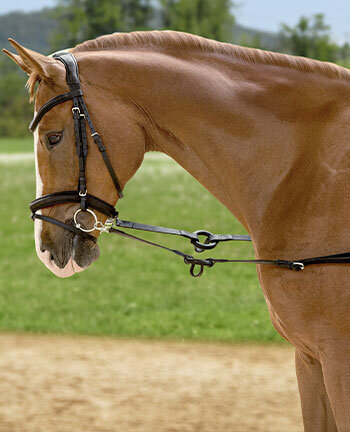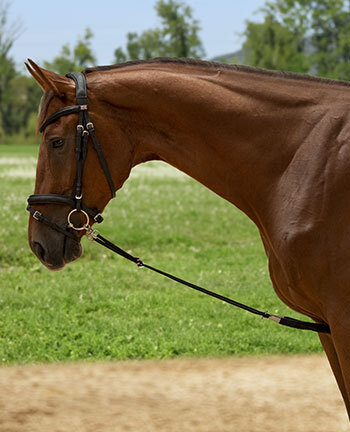Horse Training Aids
- Frequently asked questions
- What types of auxiliary reins are there?
- How do I use auxiliary reins correctly?
- Which auxiliary reins are suitable for lungeing?
- How do the different auxiliary reins work?
- Which auxiliary reins are used for hacking?
What types of auxiliary reins are there?
Martingales can also be counted among the auxiliary reins. However, as it has a different effect, it has a special position among the auxiliary reins.Auxiliary reins have the task of supporting the horse in its training or correction. Remember that auxiliary reins are not part of the basic equipment, but, as their name suggests, are intended as an aid. Unlike reins, auxiliary reins are not a direct connection between the rider's hand and the horse's mouth. Due to their different buckling, different training goals are pursued.
How do I use auxiliary reins correctly?
As their name suggests, auxiliary reins are only used to support the rider and horse. The greatest danger in using auxiliary reins is to buckle them too tightly, which restricts the horse's movement. As a result, the horse can no longer tense and relax its muscles correctly. This leads to incorrect straining of various parts of the body, which can have long-term health consequences.
Therefore, always pay attention to the correct buckling and length of the auxiliary reins, which depends on the type of auxiliary reins and the training objective. Talk to your riding instructor, trainer or an experienced rider about this.
Which auxiliary reins are suitable for lungeing?
Used correctly, lungeing is an important and valuable exercise in horse training and correction. The horse can learn to round its back and stretch its neck without the weight of the rider. Since there is no direct contact between horse and rider, it is easy for the horse to tilt in the poll and avoid the exercise. Many horses then move with their head high, their back hollow and their head constantly turned outwards.
To ensure that the positive effect of lungeing is not lost, it is a good idea to use side reins. These simulate the rider's hand and give the horse a certain guidance so that it does not break away to the outside. In addition, a contact to the bit can be achieved. When buckling the reins, however, be careful not to buckle them too tightly so that the horse does not over-bend. This will have the opposite effect.
Lauffer reins can be used in many ways and, depending on how they are buckled, can encourage the horse to stretch forward-downward or to elevate.
Furthermore, you can use lunging and training aids that also work behind the lunge roller. Many aids concentrate on the head and neck position, while the hindquarters are neglected. This can be remedied by a training system that actively involves the hindquarters in the training and promotes a forward-downward stretch.
How do the different auxiliary reins work?
Side reins are two leather straps that are attached to the girth and bit ring. They frame the horse on both sides, but do not allow forward-downward stretching. If the horse stretches downwards, the side reins act backwards and the horse over-bends. Therefore, they are at most suitable for lungeing or for beginners in seat training who want to concentrate on their seat at that moment and not on the reins and direction of the horse.
Running side reins are buckled to the side of the girth under the saddle flap, run through the bit rings and end between the front legs at the lower belly girth. As the reins run flexibly through the bit rings, it is possible for the horse to stretch forward-downward with these auxiliary reins. In contrast to the side reins, running side reins do not have a lateral boundary. The same applies here: Do not buckle them too tightly, because then otherwise the horse over-bends in the neck and moves on the forehand, which stands in the way of correct training.
Lauffer reins are very variable in their range of use and, depending on how they are buckled, can promote either stretching or elevation. Lauffer reins consist of two straps that are attached to the front saddle rings on the side of the horse, then passed through the bit rings and buckled to the girth at the level of the point of the shoulder. This not only gives the horse a slight lateral restraint, it also encourages a higher head position. Depending on the height at which the straps are buckled in, this effect is intensified or inhibited. In addition, lauffer reins can be buckled like a running side rein if a forward-downward stretch is to be achieved.
Draw reins should only be used by experienced and sensitive riders! Their mode of action is similar to a pulley, which sometimes doubles the pull on the bit. Draw reins are attached to the girth, run between the front legs up to the bit rings and are finally held in the rider's hand. This gives the rider a total of four reins in his hand. Draw reins are designed to help the rider correct a horse that is pushing upwards. It is imperative that the rider is sensitive enough to only apply as much pull on the bit as is necessary for the horse to react. Then he must immediately give way again. Draw reins are used for correction, but not for pulling the horse's head down. If the horse runs in a correct posture, the draw reins should sag.
Which auxiliary reins are used for hacking?
Riding in the country is a different situation from riding in a sheltered environment, such as an arena. While hacking, the horse moves over different surfaces, so it must be able to balance itself particularly well, for which it needs its head. The horse also needs its head and neck in moments of fright. If, however, it were to be restricted in its free movement by auxiliary reins, this could lead to tension or, in the worst case, to dangerous falls. Therefore, it is not advisable to hack with auxiliary reins.
The exception here is the martingale, which has a special position among the auxiliary reins.



